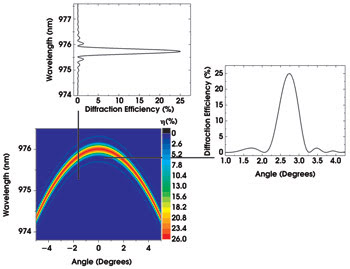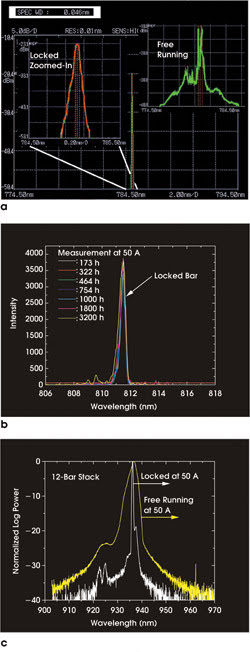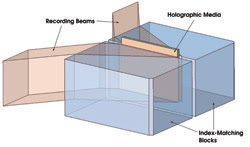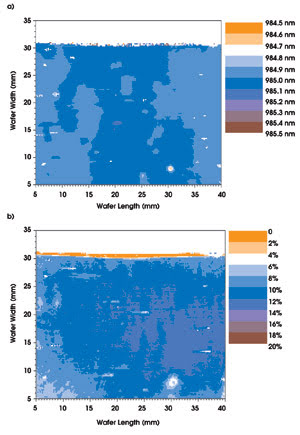Volume holographic gratings offer distinctive filter qualities.
Christophe Moser and Gregory Steckman, Ondax Inc.
The fine spectral processing capability of volume holographic gratings — holographic media where the grating is physically present throughout its volume with a thickness >100 μm — is generating renewed interest for applications in lasers, imaging, communications and astronomy.
In comparison with conventional thin diffraction gratings, which angularly spread the spectral content of a light beam, thick gratings are not dispersive. Hence, they exhibit filterlike properties but with more selective spectral and spatial features than other filtering technologies. Only the incident illumination satisfying the Bragg condition is efficiently diffracted (filtered) according to the relation λ = 2nΛcos(θ), where λ is the wavelength, n is the bulk refractive index of the media containing the grating, Λ is the grating spacing, or period, and θ is the angle of incidence (within the medium).

Figure 1. The angular and wavelength selectivity of a reflection volume holographic grating are depicted.
Only when the Bragg condition is satisfied does the diffraction efficiency reach its maximum (Figure 1). If the angle of incidence is changed, the grating can again be Bragg-matched; efficiency can be maximized if the wavelength is also changed according to the relation above. A filter bandwidth of 0.2 nm, typical for volume holographic gratings, is one order of magnitude less than that for conventional reflection thin-film filters. The fine angular selectivity — measured in tenths of a degree — occurs because of Bragg diffraction, a property that is not shared by any other filtering technology.
For most modern holographic materials, the grating is a refractive index modulation whose amplitude determines the diffraction efficiency. The orientation, or slant, of the grating relative to the boundaries of the media in which it is contained also can be controlled; for example, to prevent specular reflection from the surface propagating in the same direction as the diffracted beam. This feature is also unique to this technology. Chirping or apodizing the grating, which is the process of gradually altering the grating period and the refractive index modulation amplitude, respectively, can further alter the filter shape.
Reflection mode volume holographic gratings — also called Bragg mirrors, or volume, bulk or 3-D Bragg gratings — have narrow spectral responses with an efficiency that can be accurately fabricated to be anywhere between a few percent to close to 100 percent. With an incidence angle of 0°, the Bragg-matching condition above reduces to the simple λ = 2nΛ, and the diffracted beam will be counterpropagating to the incident beam. This wavelength is referred to as the normal incidence Bragg wavelength.
Applications
Volume holographic gratings can be precisely tailored to a particular application by changing the recording conditions. There is full control over efficiency, wavelength and diffraction angles, which enables greater flexibility in product design.
The narrow spectral response of a volume holographic grating is ideal for reducing the linewidth of multimode lasers or for forcing laser oscillation to single mode. The first use of these gratings to provide optical feedback to a laser diode was realized 20 years ago with 1.55-μm semiconductor lasers for the purpose of stabilizing and accurately setting the wavelength for fiber optic telecommunications. Accuwave Corp. of Santa Monica, Calif., followed by applying optical feedback from volume holographic gratings to lasers at 670 and 840 nm. Many other groups have since applied this technology.
The emergence of high-power diode lasers in the wavelength range of 500 to 2000 nm, plus a need for high spectral brightness — to gain more efficient pumping, frequency doubling and wavelength references — offers an opportunity to apply this technology to reduce their naturally broad linewidth.
Other advantages
As a result, butterfly-packaged lasers for Raman spectroscopy that are stabilized by volume holographic gratings are now available with power in excess of 1 W and with spectral bandwidth as narrow as 0.06 nm (1 cm–1 resolution) at 785 nm and side-mode suppression ratios of 40 dB (Figure 2a). This innovative technology enables volume production of high-power, small-footprint, ultrastable wavelength sources at low cost.

Figure 2. (a) Volume holographic gratings can reduce the broad linewidth of high-power diode lasers. Courtesy of Innovative Photonic Solutions. (b) Linear arrays of high-power lasers also can be improved by these gratings. The line shape of a 40-W laser continuously operated at 50 A remains constant over 3200 h. Courtesy of Spectra-Physics, a division of Newport Corp. (c) Wavelength stabilization of a stack of 450-W diode bars is achievable with a large-format reflection grating. Courtesy of Trumpf Laser GmbH & Co.
Linear arrays of high-power lasers also are improved with volume holographic gratings (Figure 2b). In this example, the laser bar is continuously operated at its maximum current of 50 A. The line shape — narrowed by the grating — remains constant over the observed period of 3200 h, which is encouraging for overall reliability.
Both transmission- and reflection-type gratings are manufacturable in 35-mm square wafers. Wafer dimensions are expected to scale up with market demand as they did for thin-film interference filters. The availability of large-format reflection gratings enables, for example, wavelength stabilization of a 2-D stack of high-power diode bars with a single grating element. Figure 2c shows the spectrum of a fast-axis-collimated 12-bar stack, at maximum optical power, with and without optical feedback. The spectrum of the 450-W output has a FWHM of 0.4 nm and a temperature drift of 0.006 nm/°C. By comparison, the unstabilized stack has a FWHM of 3 nm and a temperature drift of 0.3 nm/°C.
Large-format reflection gratings also are used in astronomy as rejection filters and in sensing as spectral discriminators. Multiple gratings are fabricated by a multiplexing method that consists of writing multiple holograms in the same volume of the grating without erasing the previously recorded holograms.
Ondax has fabricated multiplexed 10-wavelength gratings with a 1-in. diameter for oxygen-hydrogen emission rejection. The IR filters, which were tested at the Palomar Observatory, suppressed 90 percent of background emissions, thereby allowing the observation of very faint stellar objects. This multiline filter technology, which can be extended up to 50 lines, also shows great promise for spectroscopic signature identification.
The fabrication accuracy of the volume holographic grating’s center wavelength dictates the lasing wavelength. The center wavelength accuracy is routinely better than ±0.5 nm in a manufacturing environment, and accuracies better than ±0.1 nm have been demonstrated. This precision is more than an order of magnitude better than that achievable with state-of-the-art semiconductor laser fabrication.
Early materials were primarily photographic films, but modern photorefractive materials also include dichromated gelatin films, LiNbO3, and other crystals, polymers and glasses. Glass materials benefit from the manufacturing infrastructure supporting glass-based optical components and its low-cost volume production. Additionally, glass-based volume holographic gratings exhibit superior environmental and thermal stability.
Thermal stability and reliability are of critical importance for components to function properly over the required lifetime. In a reliability study, Ondax glass gratings were subjected to a temperature of 150 °C for 12,000 h in an uncontrolled atmosphere. The refractive index modulation amplitude and spacing of the volume holographic gratings tested did not undergo any statistically significant change during that time.

Figure 3. Amplitude and phase information is “copied” into the holographic medium, which records the single sinusoidal intensity pattern — formed by the interference of two mutually coherent plane waves — as a modulation of the refractive index.
Wafer-level fabrication
The amplitude and phase information created by the interference of two mutually coherent plane waves is “copied” into the holographic material (Figure 3). The material records the single sinusoidal intensity pattern formed by their interference as a modulation of the refractive index — called a volume grating because it extends throughout the volume of the material. Under this condition, the grating spacing is given by

where λω is the vacuum wavelength of the writing beams, n(λω) is the refractive index of the material at the writing wavelength, and θω is the angle of incidence, inside the media, of the writing beams. The beams’ angle of incidence specifies the grating spacing and, hence, the normal incidence Bragg wavelength.
According to Snell’s law, the maximum achievable angle inside the material is θωmax = asin(n0/n(λω)), where n0 is the refractive index outside the medium for the writing wavelength. This limits the grating spacing that can be written, and, consequently, the normal incidence Bragg wavelength is constrained to <500 nm. However, by introducing a glass block whose refractive index is close to that of the holographic glass, the possible wavelength range is extended to 2000 nm.
Gratings with normal incidence Bragg wavelengths from 2000 nm to approximately 3500 nm have been demonstrated using a different recording geometry. This recording process is scalable to larger wafer sizes by simply scaling the size of the optics.
Wafer-level testing
Volume holographic grating parameters are measured at the wafer level with a custom test instrument. The light from a laser, whose fixed wavelength is lower than the normal incidence Bragg wavelength of the grating being tested, is collimated and incident upon the grating wafer at an angle. The wafer is mounted on a high-precision rotation stage, and the transmitted beam is imaged onto a 2-D sensor array.
The measurement consists of rotating the wafer and measuring the intensity at a series of angles that includes the Bragg-matching angle. The Bragg angle and the readout wavelength determine the grating spacing, from which the normal incidence Bragg wavelength can be calculated. The diffraction efficiency is directly measured as the amount of power that is diffracted when at the Bragg angle (Figure 4).

Figure 4. Wafers were tested with (a) 200-μm-resolution normal incidence and (b) peak diffraction efficiency Bragg wavelength measurement data.
This automated testing system is fast and provides high-resolution data. With state-of-the-art sensors, the spatial resolution on a 35-mm wafer is better than 50 μm and is fully characterized in <10 min. Every wafer is tested 100 percent before dicing, to ensure maximum quality.
Volume holographic gratings exhibit a number of unique filtering properties, such as narrow linewidth, angular selectivity and multiplexing capability. With full user control over efficiency, wavelength and diffraction angles, the gratings can be quickly and easily customized for particular applications, including frequency-narrowed lasers, multiline filters and smart spectroscopic signature identification.
Meet the authors
Christophe Moser is president and CEO, and Gregory Steckman is director of engineering, at Ondax Inc. in Monrovia, Calif.; e-mail: [email protected] or [email protected].